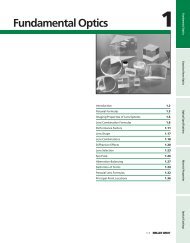datasheet: pdf
datasheet: pdf
datasheet: pdf
You also want an ePaper? Increase the reach of your titles
YUMPU automatically turns print PDFs into web optimized ePapers that Google loves.
APPLICATION INFORMATION<br />
AM26LV32<br />
LOW-VOLTAGE HIGH-SPEED<br />
QUADRUPLE DIFFERENTIAL LINE RECEIVER<br />
SLLS202D – MAY 1995 – REVISED APRIL 2000<br />
In most applications, it is not customary to have a common-mode input close to ground and to have a differential<br />
voltage larger than 2 V. Since the common-mode input voltage is typically around 1.5 V, a 2-V V ID would result<br />
in a V IL of 0.5 V, thus satisfying the recommended V IL level of greater than 0.4 V.<br />
Figure 8 plots seven different input threshold curves from a variety of production lots and shows how the fail-safe<br />
circuitry behaves with the input common-mode voltage levels. These input threshold curves are representative<br />
samples of production devices. The curves specifically illustrate a typical range of input threshold variation. The<br />
AM26LV32 is specified with ±200 mV of input sensitivity to account for the variance in input threshold. Each data<br />
point represents the input’s ability to produce a known state at the output for a given V IC and V ID . Applying a<br />
differential voltage at or above a certain point on a curve would produce a known state at the output. Applying<br />
a differential voltage less than a certain point on a curve would activate the fail-safe circuit and the output would<br />
be in a high state. For example, inspecting the top input threshold curve reveals that for a V IC 1.6 V, V ID yields<br />
around 87 mV. Applying 90 mV of differential voltage to this particular production lot generates a known receiver<br />
output voltage. Applying a V ID of 80 mV activates the input fail-safe circuitry and the receiver output is placed<br />
in the high state. Texas Instruments specifies the input threshold at ±200 mV, since normal process variations<br />
affect this parameter. Note that at common-mode input voltages around 0.2 V, the input differential voltages are<br />
low compared to their respective data points. This phenomenon points to the fact that the inputs are very<br />
sensitive to small differential voltages around 0.2 V V IC . It is recommended that V IC levels be kept greater than<br />
0.5 V to avoid this increased sensitivity at V IC 0.2 V. In most applications, since V IC typically is 1.5 V, the<br />
fail-safe circuitry functions properly to provide a high state at the receiver output.<br />
100<br />
Most<br />
Applications<br />
90<br />
V ID – Differential Voltage – mV<br />
80<br />
70<br />
60<br />
50<br />
40<br />
30<br />
20<br />
Not<br />
Recommended<br />
10<br />
0<br />
–1<br />
Increased Receiver Input Sensitivity<br />
–0.8 –0.6 –0.4 –0.2 0 0.2 0.4 0.6 0.8 1 1.2 1.4 1.6 1.8 2 2.2 2.4<br />
VIC – Common-Mode Input Voltage – V<br />
Figure 8. V IC Versus V ID Receiver Sensitivity Levels<br />
POST OFFICE BOX 655303 • DALLAS, TEXAS 75265<br />
9
















